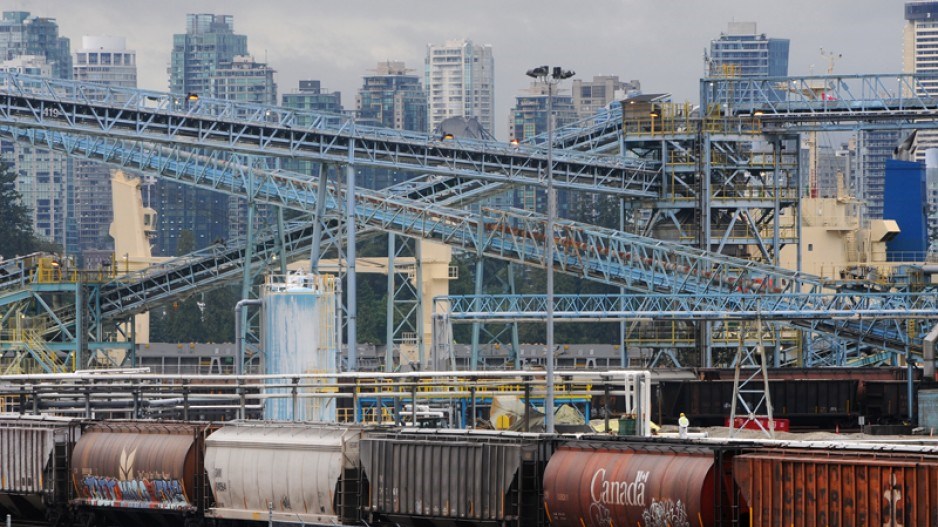Despite global supply chain SNAFUs and climate change wreaking havoc on B.C.’s highway and rail infrastructure, 2021 proved to be the busiest year ever in the Vancouver Fraser Port Authority’s history.
Total volume of goods and commodities passing through the port reached 146,473,626 tonnes in 2021, up one per cent from the year before.
The North Shore’s terminals, however, weren’t necessarily sharing in the record year.
Grain, which is exported from the North Shore’s Richardson International, Cargill Canada, and G3 terminals, was down 13 per cent in 2021.
“But even then, it was the second highest year on record for grain volumes through the port, and it just shows you how much growth has happened in the grain sector,” said Robin Silvester, port president and CEO.
Silvester said the down year in grain is due to bad growing conditions last summer, leading to a smaller harvest.
2021 was the first full year of operations for G3’s massive new terminal on the waterfront. An off year for harvests, though, doesn’t mean G3 has missed the boat.
“There's hundreds of millions invested here and hundreds of millions invested in the Prairies. Those investments are over the long term,” said Silvester. “That long-term picture for Canadian grain is still very strong. Canada's agricultural technology is improving yields. There will be good years and bad years, depending on the rain. But the long-term forecast is still for growth.”
Because of world markets being so interconnected, a war half a world away will manifest itself in the Port of Vancouver, Silvester predicted.
“The dreadful situation in Ukraine means that a lot of Russian and Ukrainian grain that would have been getting to market isn't going to,” he said. “I think Canadian grain is going to be in strong demand.”
Metallurgical coal, which is used for steelmaking, was up four per cent. Neptune Terminals has completed a series of major upgrades in the last year, which has upped their overall capacity.
Potash, which Neptune also handles, was down as well about 13 per cent. Silvester said that is largely owing to disruptions in the supply chain. It too is poised for a big rebound in 2022 due to Russia’s invasion of Ukraine.
“The other big producers of potash globally are Belarus and Russia, and it doesn't seem likely that their product will be getting to the international markets in the way that it used to,” he said. “It does show how interconnected it all is.”
Overall volumes through the port would undoubtedly be higher had it not been for the November atmospheric river taking out highways and rail lines in the Interior, Silvester said. For eight days, there was no freight service between the port and hubs to the east and for three weeks, there was only one rail line open.
The event was a wake-up call, Silvester said, but he also came away impressed with how quickly the devastated infrastructure could be brought back online.
“It actually also proved out the resiliency of our supply chain,” he said. “[It was] a remarkable testament to the ability of the government and the railways to re-establish service.”
Operations and capacity at the port don’t just impact whether our online shopping orders arrive on time, Silvester noted. They also can be a throttle for Canada’s economy as a whole. And Silvester is sounding the alarm: The lack of industrial land next to the port could soon become a major inhibitor. Local leaders should be fiercely protective of industrial zoning, he said.
“We want to see places for the people to live that are affordable and jobs that provide people with a living wage,” he said. “We have the lowest availability of industrial land for new use in the whole of North America, and that should concern everybody, because 30 per cent of the region's jobs pretty much happen on industrial land and that's just four per cent of the land base, and we're running out of that land base.”
Seaspan is currently applying to expand its drydock business to the west, which has been controversial with residents near the waterfront and the City of North Vancouver, which has put a lot of effort into developing The Shipyards public gathering place just metres away.
Rumours that a decision has already been made are just that, Silvester said, as consultations are still happening.
“I understand that's going to be happening over the course of spring,” he said. “If anyone's telling you the decision is made, I can categorically tell you that they're not correct.”




